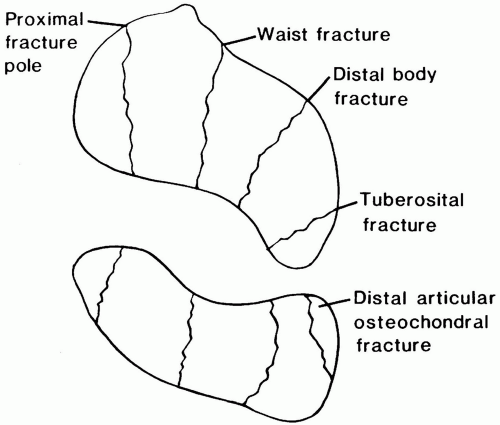Fractures Of The Wrist And Hand
Garrick A. Cox
Robert L. Kalb
FRACTURES OF THE CARPAL BONES
Fractures of the radius are often seen in combination with other fractures and dislocations. The scaphoid is the most commonly fractured carpal bone, followed by the triquetrum.
Scaphoid
The scaphoid is the most commonly fractured carpal bone (Fig. 1). The scaphoid receives its blood supply in a distal-to-proximal direction. Therefore, a proximal pole scaphoid fracture has a higher chance of nonunion.
Mechanism of Injury
During wrist hyperextension, the dorsal rim of the radius is driven into the scaphoid. Any displaced fracture of the scaphoid needs surgery.
Diagnosis
Note pain on palpation of the anatomic snuff box.
Radiology
Four views are necessary: anteroposterior with the wrist deviated ulnarward, anteroposterior in radial deviation, oblique, and lateral. Special scaphoid views can be obtained and magnified.
Initial Treatment
If nondisplaced, a thumb spica cast is applied, and the wrist is elevated. If clinical examination suggests a scaphoid fracture (pain in the anatomic snuff box), but no fracture line is seen on x-ray, a thumb spica cast is applied for 2 weeks. At that time, the cast is removed, and repeat scaphoid x-rays are taken. If repeat x-rays are still negative, but clinical tenderness is still present, continue the thumb spica and check again in 3 weeks.
Definitive Treatment
Nondisplaced scaphoid fractures require a long-arm thumb spica cast for 1 month followed by a short-arm thumb spica cast until healing is complete in 2 to 6 months. A computed tomography scan is helpful in determining whether union has occurred. Smokers heal more slowly and have a higher chance of nonunion. All patients with fractures should stop smoking. Any displaced fracture needs surgery.
Complications
The most common complications of a scaphoid fracture are nonunion, avascular necrosis, and arthritis. Nonunion and avascular necrosis require surgery. Arthritis is managed with splinting, nonsteroidal antiinflammatory drugs, injection, and activity modification. If these measures fail, surgery can be done.
Stay updated, free articles. Join our Telegram channel

Full access? Get Clinical Tree









